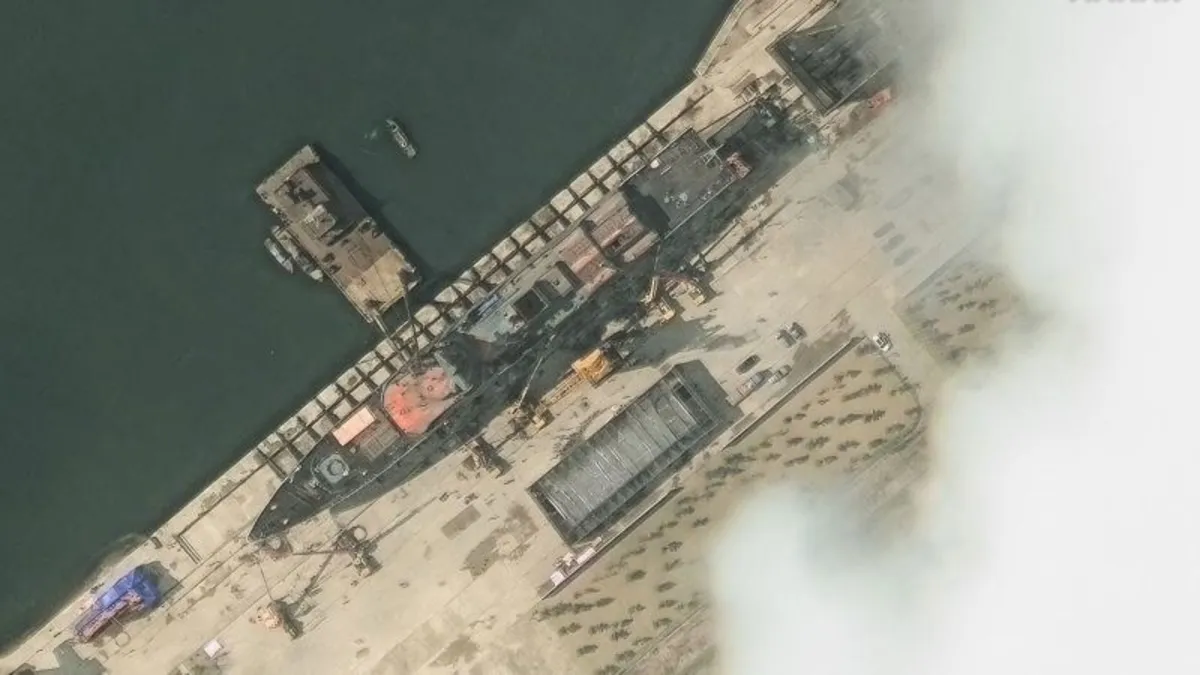
In a striking turn of events, North Korea's newest warship was severely damaged during its launch ceremony on Wednesday. The incident, witnessed by leader Kim Jong Un, has been described as a blow to the nation's prestige, prompting Kim to vow punishment for those responsible for the mishap, according to state media reports. This rare admission of failure from the official Korean Central News Agency (KCNA) indicated that a malfunction in the launch mechanism caused the stern of the yet-to-be-named 5,000-ton destroyer to slide prematurely into the water, resulting in significant hull damage and leaving the bow stranded on the shipway.
Kim Jong Un characterized the launch failure as "a criminal act," attributing blame to "absolute carelessness" and "irresponsibility" from various state institutions, including the Munitions Industry Department, Kim Chaek University of Technology, and the central ship design bureau. During a press briefing on Thursday, Joint Chiefs of Staff (JCS) spokesperson Lee Sung-joon reported that the vessel is currently lying on its side in the water, raising concerns among naval analysts about the potential for catastrophic damage.
According to maritime expert Sal Mercogliano from Campbell University, without the ship moving as intended, the stresses could "tear the hull apart." Fellow analyst Carl Schuster, after reviewing the KCNA report, suggested that the stresses could warp the hull, induce cracks, and potentially snap the keel, depending on where the greatest stress is applied.
This launch failure represents a significant setback for North Korea's ambitious naval modernization efforts, which analysts have viewed as the most substantial in decades. The damaged ship was intended to be the second major surface vessel unveiled in quick succession, following the April reveal of the Choe Hyon, North Korea's first newly constructed destroyer in years. During that launch, Kim expressed his ambition to build more destroyers, cruisers, and frigates, emphasizing the need to bolster naval readiness in response to perceived threats from the United States and South Korea.
Western defense analysts noted that the Choe Hyon marked a departure from the aging Soviet-era vessels that have long dominated the Korean People's Navy. Although specific details remain scarce, satellite imagery and reports suggest that the Choe Hyon may share design elements with similar vessels in the Russian navy. Lee, the South Korean military spokesperson, indicated that the damaged vessel was believed to be equipped similarly to the Choe Hyon, further complicating North Korea's naval aspirations.
Kim Jong Un emphasized that the damage would not only be addressed through technical repairs but also through political accountability. He called for the destroyer to be restored before the upcoming late June plenary session of the ruling Workers' Party, framing the issue as one of national honor. However, given the extent of the damage, analysts suggest it may be nearly impossible to meet Kim's ambitious deadline.
Retired South Korean Admiral Kim Duk-ki expressed concerns over North Korea's apparent lack of necessary infrastructure, specifically a dry dock, which is essential for launching and repairing such a large vessel. "A dry dock is an expensive facility, and North Korea probably doesn’t have one. It’s much easier to repair a ship once it's in a dry dock," he stated, predicting that restoration could take over four to five months.
South Korean lawmaker and defense analyst Yu Yong-weon warned that the hastened launch likely contributed to the problems encountered on Wednesday, cautioning that rushing repairs could further exacerbate the situation. Schuster echoed these sentiments, stating that any necessary repairs would likely take months instead of weeks.
In response to the incident, an accident investigation group has been formed, and senior officials may face censure at the upcoming Party Central Committee meeting, as reported by KCNA. The North Korean navy is often viewed as the least developed branch of the military, and the accelerated pace of destroyer development has raised questions about the functional capabilities of these new vessels versus their symbolic significance.
Mercogliano noted that it remains unclear whether these new warships even possess operational engines, as state media has not provided any images of them underway. The recent launch failure throws further doubt on North Korea's ability to effectively modernize its naval forces amid ongoing geopolitical tensions.